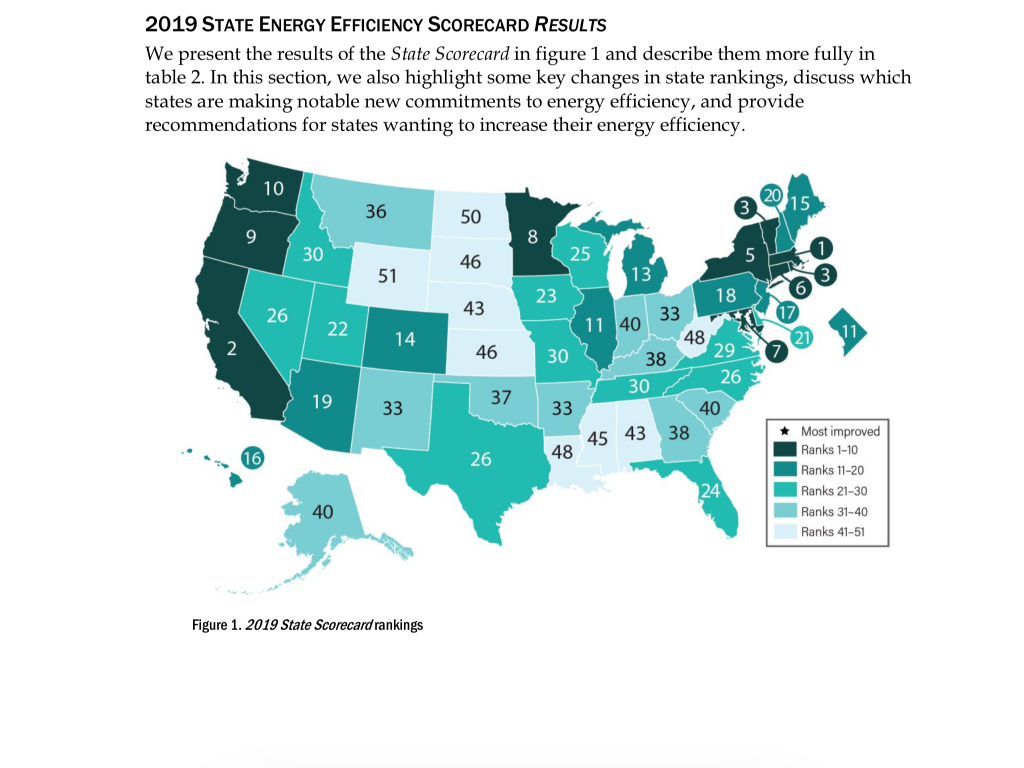California Ranked Next To the Top in State Energy Efficiency
The 2019 State Energy Efficiency Scorecard has just been released by the American Council for an Energy Efficient Economy (ACEEE). I know that you are all anxious to read the 212 page report for all 50 states plus D.C., but to make a digestible column, I will mainly focus on California.
In short, California, with a total score of 43.5 points, comes in a close second to Massachusetts with 44.5 points. 50 points is the maximum. This being the football season, we have seen a lot of this with California college teams. Actually, we are very happy that several states are doing so well in lowering pollution, since we are all in this together.
If we go down to half of the leading score, or 22.3, we include 18 of the 51 states, or 35%. The ten most populous states have the following Energy Efficiency ranks, name, population, and Energy Efficiency scores:
2 California, 39.7 million; 43.5
26 Texas, 29.1 million; 15.5
24 Florida, 21.6 million; 16.5
5 New York, 19.5 million; 37
18 Pennsylvania, 12.8 million; 23.5
11 Illinois, 12.7 million; 29
33 Ohio, 11.7 million; 14
38 Georgia, 10.6 million; 11
26 North Carolina, 10.5 million; 15.5
13 Michigan, 10.0 million; 28.5
So California (43.5), New York (37), Illinois (29), Michigan (28.5), and Pennsylvania (23.5) are the large states with high Energy Efficiency scores.
Here is their map of the states with their energy efficiency scores. The darkest colors are the most efficient levels.
There are six categories of ratings, which we give with their maximum points in parenthesis (total points maximum is 50), and California’s scores:
Utility and public benefits programs and policies (20 points) 15.5;
Transportation policies (10 points) 8.5;
Building Energy Efficiency policies (8 points) 7.5;
Combined Heat and Power (3 points) 3;
State Government Initiatives (6 points) 6;
Appliance efficiency standards (3 points) 3.
California is mainly falling short in public benefits.
Under State Government Initiatives of 6 points, Carbon Pricing will only give 1 point, or 2% of the total.
Under Transportation policies 10 points, electric vehicle registrations only give 1 point, and GHG tailpipe emission standards give 1.5 points.
California is a leader in energy efficiency standards, which were started by Arthur Rosenfeld at UC Berkeley, and the Lawrence Berkeley National Lab. He was a particle physicist and a student of Enrico Fermi. For many years he also ran the Particle Physics Data Group. He became Commissioner of the California Energy Commission from 2000-2010. He died in 2017.
The states of Washington, Colorado, Hawaii, and Nevada also follow California’s Electrical Efficiency standards. Thirteen states follow California’s fuel standards. They are Connecticut, Delaware, Maine, Maryland, Massachusetts, New Jersey, New Mexico, New York, Oregon, Pennsylvania, Rhode Island, Vermont, and Washington.
California had the largest Electrical Efficiency expenditure of the states at $1.37 billion dollars. This was 3.31% of statewide electricity revenues. However, five states spent a larger percentage, with three states being significantly larger percentage-wise: Vermont (7.80%), Rhode Island (7.26%), and Massachusetts (6.42%). The second largest state, Texas, came in at a weak 0.49%, and Florida was at 0.80%.
California had the largest natural gas efficiency program spending by a state, at $358 million. This came out to $32.52 per residential customer. Ten states topped this, starting with spending per residential customers of $165.03 for Massachusetts, $112.65 for Rhode Island, $78.05 for Connecticut, $74.52 for New Hampshire, and $64.05 for Vermont.
California, Massachusetts, and New York were tied for the leading states under Transportation at 8.5 points out of 10. However, the District of Columbia edged out all of them with a 9.0.
California had the largest number of Electrical Vehicle public charging stations at 5,120, with 12.94 per 100,000 vehicles. Four states had more per capita, being topped by Vermont at 32.73.
California’s biggest program-level monetary savings was $108 million from the California Clean Energy Jobs Act Program.
Los Angeles was 7th among cities, with a score of 65.50 out of 100 points. San Diego was 13th among cities, with a score of 58.50 out of 100.
California has the largest 2018 net increase in incremental electricity savings of 4.17 million MWh, or 4.17 TWh TeraWatt hours (4.17 x 10^9 kiloWatt-hours), which is 1.62% of 2017 retail sales. The US incremental savings total was 27.1 TWh, or 0.73% of 2017 sales. So California’s was 15.4% of the nation’s incremental savings. The total annual savings per year of all of the incremental savings since 1989 is about 260 TWh.
In 2018 the California incremental fuel savings of California was just slightly behind Michigan’s, and was 1.01% of current sales, at 7.94 million MMBtu. The US total was 0.47% at 46.1million MMBtu. California’s savings is 17.2% of the nation’s total. MMBtu means a thousand thousands, or a million Btu, which is 10 of the therms that appear on your monthly natural gas bills.
It’s great to see progress continuing even through the present administration of 2017 and 2018.

